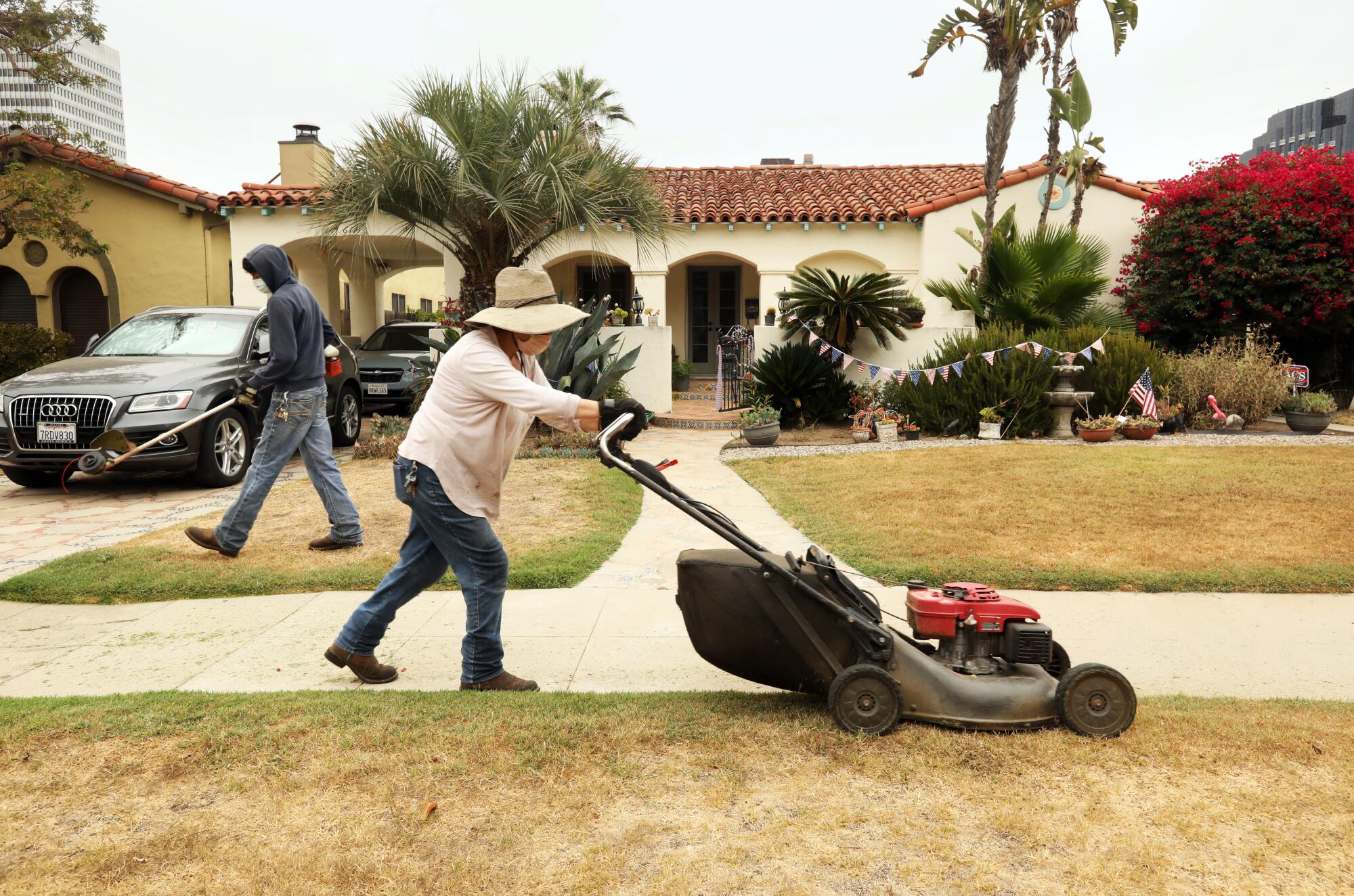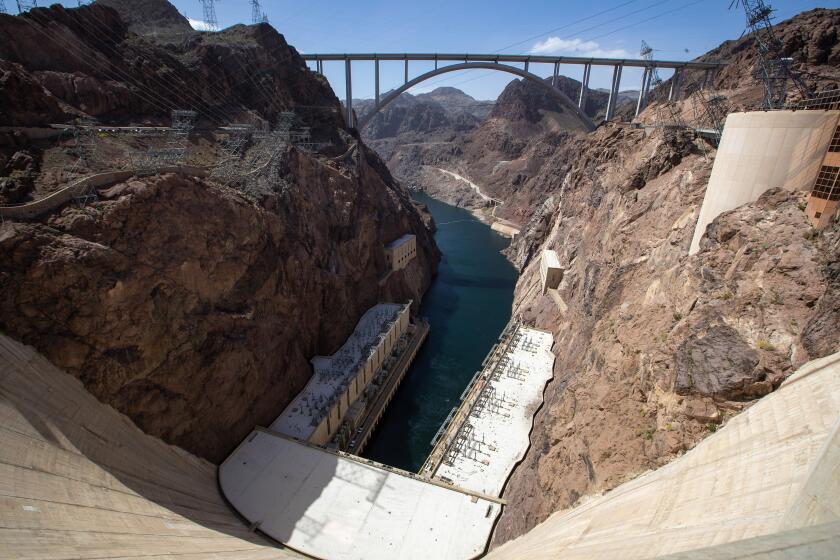
- Share via
California’s second wet winter in a row has left L.A.’s water supplies in good shape, and the city has used its reprieve from drought to make progress on water-saving infrastructure projects. But the inevitable return to dry conditions could once again put the city’s residents in a precarious position.
After the state’s final snow survey of the season, officials with the Los Angeles Department of Water and Power announced that Eastern Sierra snowpack is measuring 103% of normal, “providing ample supplies through the city’s most cost-efficient water supply from the Los Angeles Aqueduct.”
The aqueduct — two pipelines that deliver water from the Mono Basin and Owens Valley hundreds of miles away — is the backbone of L.A.’s water system. The recent rain and snowpack have filled the DWP’s reservoirs in the region and will allow the aqueduct to meet approximately 70% of the city’s water demand. That equates to about 114 billion gallons of water, or enough for about 207,000 households for a year.
Agency officials said they have also been able to capture 30 billion gallons of stormwater since last fall, or enough to meet 20% of the city’s annual water demand. The remaining supplies will come from recycled water and water imported from the Metropolitan Water District of Southern California, they said.
Aggressive and impactful reporting on climate change, the environment, health and science.
Although current conditions are promising, L.A. must maintain its ethos of conservation and prepare for dry times ahead. El Niño, the climate pattern that helped drive California’s recent stormy conditions, is expected to wane in the weeks ahead, and there is an 85% chance that its drier counterpart, La Niña, will develop by late fall or early winter.
“While our reservoirs are full following two wet winters, we are still seeing the impacts of climate whiplash across the state,” read a statement from Martin Adams, the DWP’s general manager and chief engineer. “We know we have to stay focused on our investments in local water supply projects as LADWP continues to evolve and balance the needs of our customers with the challenges associated with extreme weather patterns. More than anything else, we encourage our customers to stay vigilant in their water-wise practices, which have helped keep water conservation citywide near record highs.”
Indeed, it was only two years ago that Angelenos were experiencing a devastating three-year stretch of drought and living under the strictest water restrictions the region has ever seen. Hillsides were caked and brown, city streets were dotted with dead lawns, and wildfires raged throughout the state and region, feeding on bone-dry grass and shrubs. Southern Californians were limited to just 80 gallons of water per person per day.
This graphic plots a 20-year history of the Sierra snowpack, recalling several other wet years and many more recurring spells of drought.
The city has used the wet reprieve to make progress on some of its marquee water projects, including its Tujunga spreading grounds facility in the San Fernando Valley, according to Anselmo Collins, the DWP’s senior assistant general manager. The facility is already working to treat the polluted groundwater basin and provide enhanced groundwater storage. When fully completed, it will deliver nearly 12,200 acre-feet of annual recharge and have the capacity to treat more than 55,000 acre-feet per year. (An acre-foot is about 326,000 gallons.)
“It’s already showing huge benefits, because we’ve been able to increase how much we capture and put back into the ground,” Collins said. He said the Tujunga project and other treatment facilities in the Valley, including two fields in North Hollywood, were largely behind the 30 billion gallons captured so far this season.
Another project that’s progressing is the Donald C. Tillman water reclamation plant in Van Nuys, which will use recycled wastewater to replenish the San Fernando groundwater basin. Construction is expected to begin later this year, and the plant could add 21,000 acre-feet of supply to the city as soon as 2027, Collins said.
“I do think we’re better prepared, and I think we are continuing to be better prepared [for dry conditions],” he said.

But other water capture and storage efforts have been slower to get off the ground, including the Safe Clean Water Program, passed in 2018 as Measure W. The program allocates $280 million a year toward projects that convert asphalt and other hard surfaces into porous materials that allow water to percolate in the ground, among other efforts. It added only 30 acres of green space to the county in its first three years, a recent report found.
Mark Gold, director of water scarcity solutions for the Natural Resources Defense Council, said L.A. residents were right to be frustrated by the billions of gallons of stormwater that were funneled into the Pacific Ocean through the L.A. River, Ballona Creek and Dominguez Canal during this winter’s storms.
“The potential of what we can do is just so much more,” he said.
California has an above-average snowpack and the state’s reservoirs are mostly filled, bringing a substantial boost to water supplies.
In fact, though L.A. has made progress on some projects over these two wet years, Gold said too much of the work is too far from completion. He’s not convinced the city is more prepared for the next drought than it was the previous one.
“There’s nothing magical that’s happened in two years that helps us be more resilient to this huge climate variability,” he said. “We’re certainly not in a much better place today than we were prior to this wet season.”
Among his biggest concerns is slow progress on the plan to transform the Hyperion Water Reclamation Plant from a wastewater treatment facility into an an advanced water purification facility, which could boost local supplies by more than 200 million gallons of water per day, or nearly half of the city’s water demand.
Part of a partnership with L.A. City Sanitation, that project had been billed as Hyperion 2035, but it’s way behind schedule and unlikely to be fully complete until at least 2045 or even the 2050s. The reclamation plant has also been plagued by infrastructure issues and maintenance problems — including a major 2021 sewage spill — partly induced by overflow and debris from strong storms.
“We’re very, very concerned that additional major improvements are needed at the Hyperion treatment plant to just do the basics of treating wastewater to secondary treatment levels, especially during extreme storms, but even year-round,” Gold said. “And now that the city is in a growing budget crisis, that concern, which already existed, is being elevated.”
L.A. City Controller Kenneth Mejia recently warned residents that the city is facing a projected budget deficit of $476 million.
The Metropolitan Water District, meanwhile, recently announced that it will increase rates and property taxes throughout the region over the next two years to help cover the cost of climate change adaptations, water imports and treatment, and revenue declines. The agency this month also signed an agreement with the DWP to provide up to $139 million over 25 years to support groundwater replenishment efforts, among other investments in the region.
Collins said the city’s budget deficit may not affect the DWP directly, as the agency has its own budget, but it could affect resources, staffing or other support the DWP receives from city departments.
“We are not impacted directly by those challenges, but certainly, as a member of the city family, the expectation is that we are going to be even more diligent in ensuring that we are investing the ratepayer dollars in the most responsible fashion,” Collins said.
Similarly, Metropolitan’s rate hikes could trickle down to DWP customers, he said; however, the DWP expects to purchase only a small amount of water from the wholesaler this year given its surplus of supplies.
The Metropolitan Water District, which delivers imported water to Southern California, is raising rates and property taxes to cover rising costs.
There are other developments on the horizon as well, including progress at the state level that will benefit Los Angeles, Gold said.
Among them is a statewide ban on watering non-functional turf, which is expected to lead to considerable water savings. A proposed regulation known as “Making Conservation a California Way of Life” would develop a regulatory framework for achieving long-term water use efficiency and is expected to be voted on by the State Resources Control Board this summer.
“Those actions take years to occur, and that’s something that I hope everybody understands, is that you can’t build climate resilience overnight,” Gold said.

Collins said California’s back-to-back wet winters should leave the city in good shape for a least two years. “Now it’s a matter of managing that supply, managing our demands, and building more projects that are going to allow us to have even more access and even more resiliency in our system,” he said.
However, should the state face another drought that stretches three, four or more years, it’s not impossible that residents could see brown lawns and strict rules once again, he said.
That possibility looks increasingly likely as the La Niña outlook strengthens. There is a 65% chance that La Niña will develop by August, and an 85% chance it will be here by early winter, according to the National Oceanic and Atmospheric Administration.
La Niña was last in place from 2020 to 2023 — a window that included the state’s driest three years on record.
In fact, while some of the city’s current surplus can be credited to careful planning and preparation, a lot of it also had to do with luck, Gold said. Mono Lake has seen a 5-foot elevation increase since 2022 thanks to consistent winter storms.
“The miracle was the gift of nature,” he said. “And luckily, Angelenos got to benefit from it.”













